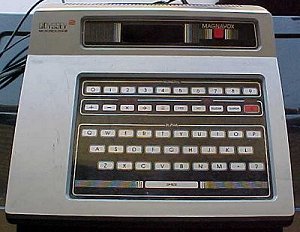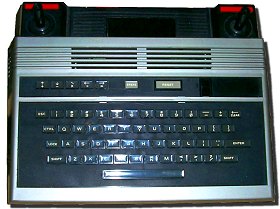 The late 70s and early 80s saw the birth of what is now one of the hottest and most lucrative fields in the electronics industry with the introduction of home video games that weren’t tied down to playing a television equivalent of table tennis.
The late 70s and early 80s saw the birth of what is now one of the hottest and most lucrative fields in the electronics industry with the introduction of home video games that weren’t tied down to playing a television equivalent of table tennis.
The growing home video game craze was far different from its current incarnation, where 16-bit graphics and stereo sound make or break a game. In these days, abstractions were readily accepted so long as the game play itself was suitably enjoyable. Also, the arcade video games hadn’t gotten too terribly advanced or fancy yet; they too still relied on symbols which were, at best, cartoon representations of the player or his computerized opponents. The play, as they say, was the thing. So long as the cake itself tasted good, the icing didn’t need to be too elaborate. It was the age of such games as Pac-Man, Defender, Frogger and Tempest. You couldn’t make a movie out of these games. Arguably, you didn’t even have to make sense of them.
One of the earliest variations of this kind of game system was the Odyssey2, originally introduced by Magnavox. Whereas one might consider the Odyssey’s contemporary, the Atari 2600, to be the Model T of home video game systems, the Odyssey would probably best be compared to the Tucker Torpedo or the DeLorean – way ahead of its time with some embellishments that are considered bottom-line features today. Its keyboard, while seldom utilized to its fullest potential, opened a lot of avenues that simply hadn’t been considered. Some so-called educational games were now possible that went beyond simple arcade-style games that made token concessions to their educational nature. Though few of them really stretched the envelope of their genre, some were truly exceptional and couldn’t be found on any other systems, including a math drill game that relied on keyboard input instead of a joystick, and another piece of software devoted to allowing the exploration of simple computer programming (if only in the Odyssey’s resident cryptic-going-on-pictographic language).
But while it’s easy to be academic and reflect on the wonderful educational value of any piece of software, let’s not forget the reason most of us were drawn to one machine or the other – the games! Early on, the budget allotted to the Odyssey2 and licensing limitations meant that a lot of the popular games which were available for the Atari 2600 weren’t even an open option. But this didn’t stop the programmers from some very close approximations that added enough of a twist to make the game different. Alien Invaders – Plus! (the exclamation point ![]() was a traditional part of every Odyssey game’s title) took the same basic idea as Space Invaders but made subtle alterations. Blockout!/Breakdown! very closely imitated the popular Atari game Breakout, but added a variety of interesting twists that made the game more challenging, in some cases more confusing, and absolutely riotous in the two-player mode. Other games were closely approximated with very interesting variations on their themes, such as K.C. Munchkin! (Pac-Man), Pick Axe Pete! (Donkey Kong), Attack of the Timelord! (Galaga), UFO! (Asteroids), Freedom Fighters! (a rather weak version of Defender), and so forth.
was a traditional part of every Odyssey game’s title) took the same basic idea as Space Invaders but made subtle alterations. Blockout!/Breakdown! very closely imitated the popular Atari game Breakout, but added a variety of interesting twists that made the game more challenging, in some cases more confusing, and absolutely riotous in the two-player mode. Other games were closely approximated with very interesting variations on their themes, such as K.C. Munchkin! (Pac-Man), Pick Axe Pete! (Donkey Kong), Attack of the Timelord! (Galaga), UFO! (Asteroids), Freedom Fighters! (a rather weak version of Defender), and so forth.
Around 1982 or so, North American Phillips – the parent company of Magnavox which had made the Odyssey2 more successful by making it its own product rather than just another offshoot of Magnavox – allowed a first in the form of a licensed arcade adaptation (a game called Turtles). And at long last, third-party manufacturers such as Imagic (who had already manufactured games for the Atari 2600 and Mattel’s equally obscure Intellivision home game system) and Parker Brothers (who had also produced home versions of games like Frogger and Q*Bert for other systems) began to pay heed to the Odyssey2.
 Not long after, NAP announced the Odyssey3 – with a more traditional keyboard, much more advanced graphics (including revamped versions of existing games like Pick Axe Pete), and the capacity for such peripherals as disk drives and modems – and it seemed like the Odyssey had finally advanced sufficiently to survive longer than the Atari 2600, which had also reached its hardware limits around this time.
Not long after, NAP announced the Odyssey3 – with a more traditional keyboard, much more advanced graphics (including revamped versions of existing games like Pick Axe Pete), and the capacity for such peripherals as disk drives and modems – and it seemed like the Odyssey had finally advanced sufficiently to survive longer than the Atari 2600, which had also reached its hardware limits around this time.
Then it disappeared. The third-party games were released in very limited numbers. The Odyssey3 project was not developed, and the Odyssey2 quickly vanished into obscurity. Home computers ruled the market now, and the home video game machines were pushed out of the way. Even higher-end home game machines like the Colecovision and Atari’s 5200 and 7800 models lost out to the fledgling PCs, the Apple II and the Commodore 64. The first home video game revolution ended after barely a five-year reign. The time of the home game system would not arrive again until the late 1980s with the names of such firms as Nintendo and Sega at the forefront. But in that time, computers had become prevalent, and the heart of video gaming had changed from an abstract form of entertainment with the emphasis on compulsive playability to a more violent, realistically gritty style with more attention to bells and whistles.
[jwcatpostlist orderby=title order=asc includecats=25,41,319]
Odyssey3 photo courtesy of Fred Hiss.
